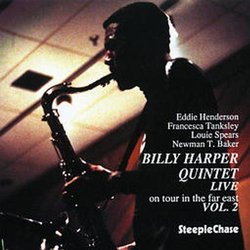| All Artists: Billy Harper Title: Live on Tour in the Far East Members Wishing: 0 Total Copies: 0 Label: Steeplechase Original Release Date: 1/1/1996 Re-Release Date: 12/1/1995 Album Type: Import Genres: Jazz, Pop Styles: Modern Postbebop, Bebop Number of Discs: 1 SwapaCD Credits: 1 UPCs: 716043132126, 723721876326 |
Search - Billy Harper :: Live on Tour in the Far East
 | Billy Harper Live on Tour in the Far East Genres: Jazz, Pop
|
Larger Image |
CD Details |
CD ReviewsOne of the greatest. Belongs to every jazz collection. Teemu Mäki | Helsinki, Finland | 01/11/2007 (5 out of 5 stars) "
Billy Harper is one of the giants. Unlike John Coltrane he has not conquered any really new artistic frontiers, but he has mastered tenor saxophone absolutely as thoroughly as Coltrane, Sonny Rollins, Dexter Gordon, Pharoah Sanders - or Stan Getz, who sound-wise is Harper's opposite. And as his sound is instantly recognizable, he is unique enough too. His sound is closest to the Coltrane of the Atlantic or early Impulse years, but his sound is even harder and louder. It's the ultimate embodiment of the so-called "texas-tenor" sound, that would cut through any distracting noise even outdoors and without amplification like an inhumanly powerful street preacher. And a preacher he is as you can always here passionate gospel roots both in his playing in the melodic and harmonic structure of his compositions. However, an atheist like myself can enjoy this religious fervor. A fictitious thing like god is easy to pass by, but the very concrete and human struggle, longing and attempts at creating some meaning and structure for one's life that I hear in Harper's music is emotionally gut-wrenching and philosophically realistic. When listening to Haprer, the weighty and hard-edged sound is of course what one encounters first, but the next thing is the architectural clarity of his solos: he plays very long - often stretching a song to 20 or even 30 minutes, but without any rambling, ornaments or wasted notes. Instead he just builds logically from one phrase to the next, from one harmonic base to the next, with such a clear sense of purpose that following this is like following a speeded up-film of a huge, austere cathedral being built. It's real real-time composition, where each note has a proper place and function. In this Harper is quite the opposite of for example the baroque utterings of let's say David Murray - not automatically better, but very different. Murray in his solos runs frantically around the song starting out as many trains of thought as he can and not worrying how many of these trains really go anywhere, whereas Harper kicks on the engine of just one train but rides that one with supreme authority, twisting its rails where ever he wants to go. As an improvising strategy it's close to that of Mal Waldron and Steve Lacy. He has mostly worked with an astonishingly small self-penned repertoire, with compositions such as Priestess, Cry of Hunger, Trying to Make Heaven My Home, Destiny Is Yours, Soran-Bushi and I Do Believe, added with a few standards like Coltrane's Countdown and Hart & Rodgers' My Funny Valentine. In this he reminds me of Randy Weston, since both of them have produced a fairly small body of compositions, but of the highest quality, and been content to tackle them again and again - and with stunning results. To keep playing the same compositions for about 30 years may sound like an impasse, but if you think how for example many masterful classical Indian musicians keep on patiently versioning their same old pet ragas - and finding new in them - for dozens of years, it is not that miraculous that the same practise can be proven good in jazz too. Harper has only made 15 records of his own, his first was Capra Black on Strata-East label and the second was Black Saint, which started the Black Saint record label. Four years later his In Europe started its sister label, Soul Note. Each of these is a well-prepared and fully achieved artistic statement, which partially makes up for the relative smallness of his recorde output. In 1995 Steeplechase released three albums of live recordings from Harper's quintet's (Eddie Henderson on trumpet, Francesca Tanksley on piano, Louise Spears on bass, Newman Baker on drums) tour in the Far East in 1991. All three are perfect live jazz releases. Harper plays with unflagging vigour and invention, longest tune is 35 minutes long - without a single flabby moment - and the other main soloist, Eddie Henderson is the perfect lyrical counterpart to Harper's stentorian preachings. The recording is in it's way great too, the horns are in your face, which makes them really physical and fearsome. It resembles the thorny and aggressive sound of the Coltrane Impulse live recordings, since in those too the horns were as close-up as possible, really carving their way directly to the listeners' brains. Luckily, in Harper's Steeplechase records the rhythm section is better recorded than on those old Impulses. This kind of unvarnished live recordings are scarce nowdays, since the Blue Note and especially Telarc sound of today is so distant, harnessed, smoothed out and tame, that it often simply castrates the sound of the artist. This particular Harper album is my favorite because it features his perhaps best composition, Priestess, and gives the definitive version of it. Gil Evans' big band used to play it a lot and recorded a wonderful version of it for an album by the same name, but this Billy's quintet version is maybe even better. A desert island disc if there ever was one." |

 Track Listings (4) - Disc #1
Track Listings (4) - Disc #1